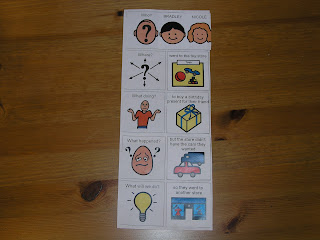To "treat" his impairment in verbal reasoning, Brad's private speech language pathologist engages Brad using printouts like the one pictured above.
It starts with W questions, who, where and what.
Then it moves to "what happened".
And then what I call the syllogism prompt: "what will we do?"
Every week, they work on a new "story" that follows this basic interactive format. The column on the left (the W questions and the syllogism prompt) does not change. The SLP leaves me a printout so I can reinforce and practice in between sessions.
Goals, by their nature, should be something to strive for, not something already mastered, and that's why I really like this intervention. Currently, Brad doesn't really get it. He can't deduce, or problem solve yet. That last "what will we do?" question consistently trips him up. But he even though he can't formulate deductive reasoning, I think he is starting to comprehend these little syllogisms, perhaps in a passive way. But comprehension isn't for nothing. Little by little, I like to think that this type of intervention does exercise those tenuous "higher order" synapses, perhaps keeping them from dying off or causing them to flourish.
I will close with a proof point: I set the table the other day and forgot to set cups with the kids' drinks. Brad: "Mommy, you made a mistake!" (Ha! And it won't be the first, Brad.) Now that's deductive reasoning.
Added: The printouts pictured above were created with BoardMaker.





4 comments:
Thank you!!! My SLP really loved this (I c&p to her email) and is working to incorporate it. This is coming from a person who had a hard time believing for a long time that he even has Autism. Boy, she is learning!
DS has a super hard time with stuff like the grocery store - if we are headed towards the pork loins and I say I'm going to get one.. and then I change my mind b/c they are too expensive.. he loses it. It's not just if he cares about the item, it's because it's on THE LIST.
I hadn't thought about it in these terms before, but it is certainly worth a try to see if seeing it concretely on paper will help him to understand why we are leaving w/o part of our list.
Our SLP has been against PECS for quite sometime... but seeing this post I think changed her mind b/c she can see the benefit in CONCRETE vs ABSTRACT even for HF kids now. YAY you!!
I know that's not the exact same as what Brad's working on. But, it helped us!! Thanks!
oh wow. You rock.
You know, when I first saw the printouts, I thought they were not right for Brad. Why give him the visual cues when the point is to teach him to talk? I've completely come around on that one. This is a situation where the label fits. The autism label, that is. Supplementing the auditory cues (ie talking) with the visual cues (the pictures) allows him to go farther overall, in terms of comprehension and communication. And that's the goal.
For me the roadblock was 'He's so way past THAT. He can read, and he's verbal, why are we doing pictures?'
But the truth is that anything that can turn abstract into concrete is helpful right now.
I also think that for verbal kiddos, maybe the PEC type things come into play a little later on. Once we get to some HARDER, as you say, higher level stuff.
My words don't mean a HILL OF BEANS to him in the store... but I'll bet this does. I'll give an update!
Great job - Thank you so much for the great idea !
I am going to email your post to my SLP as well
Post a Comment